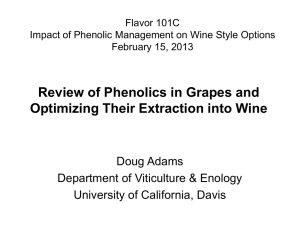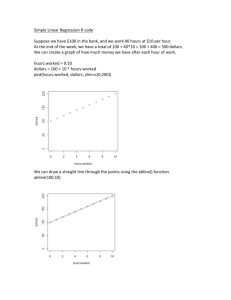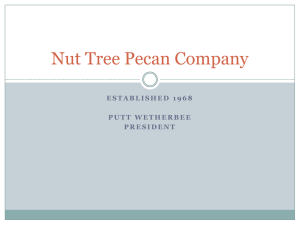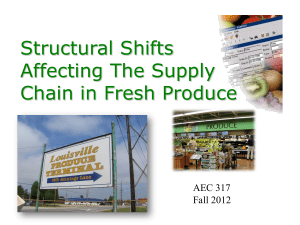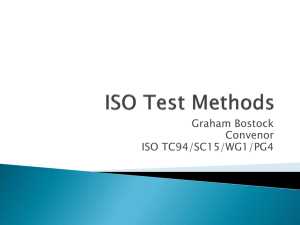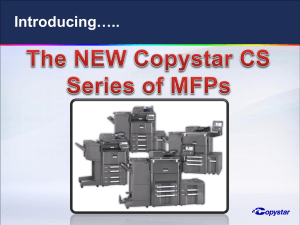Access the file
advertisement
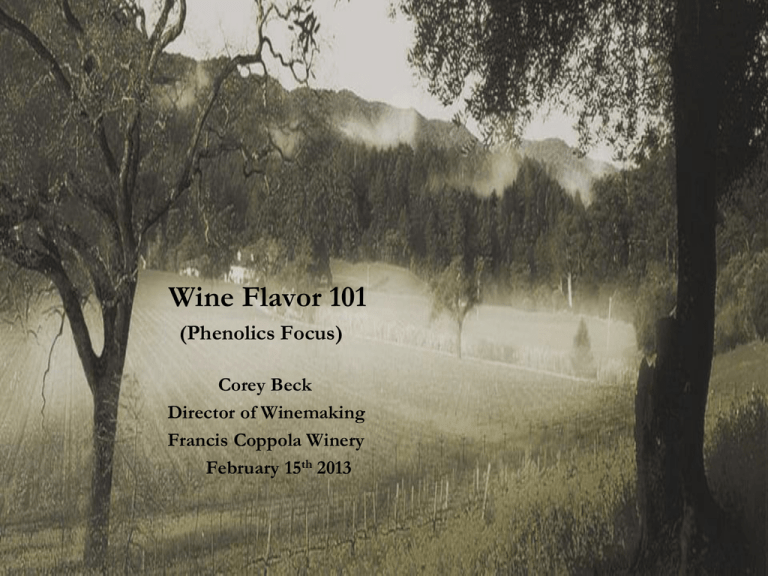
Wine Flavor 101 (Phenolics Focus) Corey Beck Director of Winemaking Francis Coppola Winery February 15th 2013 Phenolic Profile Assay in Winemaking • Adopted Harbertson-Adams Assay in 2003: – Anthocyanin: “color” measured by spec at 520 nm – Tannin: measured by protein precipitation – Total Phenols: Iron reactive • Real-time ‘in-house’ wet chemistry analysis for measuring color, tannin, total phenols and polymeric pigments. Very useful tool, especially during harvest and macerations. • The assay quantifies phenolic compounds in wine by measuring and analyzing the chemical properties of those compounds. It separates chemicals into functionally-defined categories. • 2.5-3 Hour Run Time How Can Assay Help With Winemaking Decisions? • Use Phenolic Assay to provide grower feedback – Adjustments in the vineyard to reach quality goals – Grower becomes part of ‘goal oriented winemaking’ • Quantify Theories – Measure amount of tannin/anthocyanin lost using fining agents • Assist in defining wine ‘Style’ – Vintage quality How is Phenolic Data Useful to Growers? • Helps grower understand wine style so adjustments can be made in vineyard • Creates Third Party if there’s a difference in opinion over wine quality • Helps define quality and closes the loop between grower and consumer • Gives grower more data to market their fruit Typical Graph Presented to Grower Revealing Phenolic Data- 2007 Cabernet Sauvignon 4000 3500 3000 ANTH PPM 2500 TAN 2000 PHE TOT 1500 BRIX*100 1000 500 0 1 2 3 4 5 6 DAYS IN FERMENTOR 7 8 ANTHOCYANIN (PPM) Define Wine Style for Grower: Claret 1400 1200 2006 Claret 2007 Claret 2007 Grower Lot 1000 800 600 0 200 400 600 400 800 1000 1200 TANNIN (PPM) 200 0 •Target a given wine style within the confines of each vintage •Grower has greater sense of ownership to the wine and vintage Phenolic Assay Can Help Quantify Beliefs • Blending – Allows for earlier blending of similar lots based on the combination of sensory, chemistry and phenolics • Fining – See which agents affect tannin fining without significant color loss • Drain & Press – Make ‘real time’ decisions with stylistic considerations – Measuring daily phenolics to help with pressing/pump-over decisions Measuring Anthocyanin Blending Zinfandel and Petite Sirah during fermentation 1400 1200 PPM 1000 PS ZN ZN+10%PS 800 600 400 200 34% Higher Color 0 1 2 3 4 5 6 7 8 9 10 11 12 DAYS IN FERMENTOR Measuring Tannin Blending Zinfandel and Petite Sirah during fermentation 1200 1000 PPM 800 PS ZN ZN+10%PS 600 400 200 0 1 2 3 4 5 6 7 8 9 10 11 12 DAYS IN FERMENTOR Fining Agent (Gelsol) and it’s Effect on Tannin 2009 Dry Creek Zinfandel 350 340 330 12% PPM 320 310 300 290 280 270 Control #1/8/M Gelsol #1/4/M Gelsol Rates of Gelsol #1/2/M Gelsol Fining Agent (Gelsol) and it’s Effect on Anthocyanin 2009 Dry Creek Zinfandel 400 350 PPM 300 250 200 150 100 Control #1/8/M Gelsol #1/4/M Gelsol Rates of Gelsol #1/2/M Gelsol Phenolic Assay Assists in Defining Style • Use of Phenolic Assay to Plot Anthocyanin and Tannin • Helps with vineyard and varietal selection • Use Phenolic Assay as a tool to help define program and asses quality • Keeps vintages consistent • Creates history of vineyards/growers for winemaking team and owners ANTHOCYANIN (PPM) Identifying Wine Style- Claret 1400 2006 Claret 2007 Claret 2008 Claret 1200 1000 800 600 0 200 400 600 400 200 0 800 1000 TANNIN (PPM) 1200 2009 Anthocyanin -Claret Components 1000 900 Anthocyanin ppm 800 700 600 500 09CS Antho 09CF Antho 09MB Antho 09PV Antho 400 300 200 100 Days in Fermentor 0 1 2 3 4 5 6 7 8 9 10 2009 Tannin- Claret Components 1600 1400 Tannin ppm 1200 1000 800 600 09CS Tannin 09CF Tannin 09MB Tannin 09PV Tannin 400 200 0 1 2 3 4 5 6 Days in Fermentor 7 8 9 10 ANTHOCYANIN (PPM) 2009 Claret Elevation 700 800 700 TANNIN (PPM) 600 800 900 500 1000 1100 2009 Claret 2009 Cabernet S. 400 • Addition of (CF, PV & MB) adds more Color and Tannin Tasting: 2010 Archimedes Tasting: 2009 Eleanor Syrah- Cabernet Sauvignon Blend 2009 Eleanor Color & Tannin Extraction 1200 parts per million 1000 800 600 Color Tannin 400 200 0 0 1 2 3 4 5 Day of Fermentation 6 7 8 Summary • Help improve winemaking decisions – Blending – Fining – Pressing • Improve Grower Relationships • Help Identify Wine Style • Gauge Vintage during harvest • Many thanks to: • Evan Schiff and Tondi Bolkan-Use of Harbertson-Adam Assay in production world • Drs. Jim Harbertson & Doug Adams • Lise Asimont-Director of Grower Relations, Francis Ford Coppola Winery • The Growers of the Francis Ford Coppola Winery

